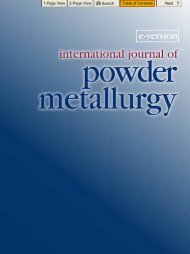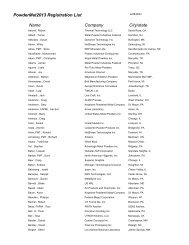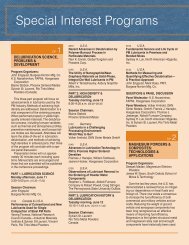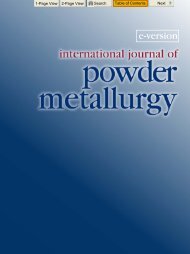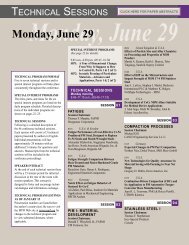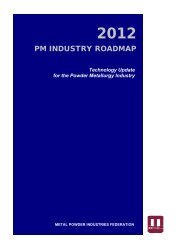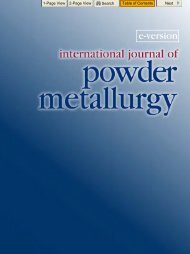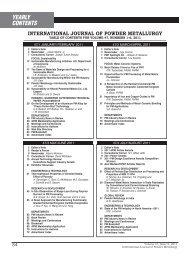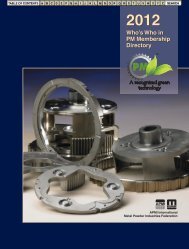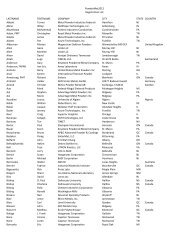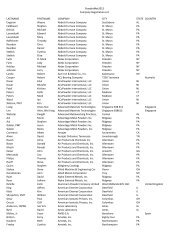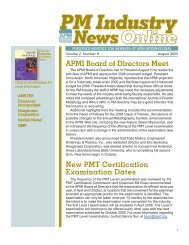E-IJPM: Vol. 44/4 - MPIF
E-IJPM: Vol. 44/4 - MPIF
E-IJPM: Vol. 44/4 - MPIF
Create successful ePaper yourself
Turn your PDF publications into a flip-book with our unique Google optimized e-Paper software.
missions contain 8.2 to 11.8 kg (18 to 26 lb.) of<br />
PM parts. The new GM High-Feature 3.6 L V-6<br />
DOHC engine contains about 16.3 kg (36 lb.),<br />
which is more than the total PM parts content<br />
was in the average U.S.-built vehicle in 1998. It is<br />
a world engine made in Australia, Canada, Japan,<br />
and the U.S.<br />
Another new product is the dual-clutch transmission,<br />
a growing product that contains about<br />
7.2 to 8.2 kg (16 to 18 lb.) of PM parts.<br />
The next generation of North American-built<br />
diesel engines, scheduled for introduction during<br />
the 2009 to 2011 timeframe, is another bright<br />
spot. Applications include PM cam-gear drives,<br />
idler gears, timing-system sprockets, and fuelinjector<br />
gears. In addition, powder-forged connecting<br />
rods and PM bearing caps are currently<br />
undergoing validation testing. The outlook for<br />
acceptance looks promising. Observers are forecasting<br />
that diesels could capture 20 percent of<br />
the North American engine market within the next<br />
10 years.<br />
Because of the shift away from full-size SUVs<br />
and light trucks to crossover vehicles and cars,<br />
the average PM content per vehicle has stabilized<br />
in 2008 at 19.5 kg (43 lb.), the same as in 2007.<br />
This number will improve when production volumes<br />
are expected to normalize at an annual rate<br />
of 15 million to 15.5 million light vehicles after the<br />
second quarter of next year. In contrast, the average<br />
European-built vehicle contains 10 kg (22 lb.)<br />
of PM parts, and the average car built in Japan<br />
about 8.6 kg (19 lb.) of PM parts, Figure 4.<br />
Over the past year, in an effort to determine<br />
Figure 4. Estimated weight of PM parts/components in a typical vehicle.<br />
(1 lb. = 0.455 kg)<br />
<strong>Vol</strong>ume <strong>44</strong>, Issue 4, 2008<br />
International Journal of Powder Metallurgy<br />
STATE OF THE PM INDUSTRY IN NORTH AMERICA—2008<br />
more than just the weight of PM parts in a typical<br />
vehicle, <strong>MPIF</strong> has been working with its member<br />
companies to assess the total number of actual<br />
applications and total parts in a typical vehicle.<br />
Although this extensive study is not yet finalized,<br />
at a minimum, a typical North American car has<br />
more than 230 different applications containing<br />
over 750 total PM parts. Since we are still gathering<br />
data, these numbers are conservative and will<br />
undoubtedly increase when additional data are<br />
collected.<br />
THE MIM MARKET<br />
The North American MIM market is expected to<br />
grow in the range of 10 to 15 percent this year.<br />
The market in 2007 is estimated at about $155<br />
million in sales from 20 to 25 job shops. Medical<br />
products, firearms, and hand tools are the top<br />
three domestic markets. Only a handful of MIM<br />
parts makers produce automotive applications,<br />
the most important of these being turbocharger<br />
vanes. Injection molding has been successful in<br />
making hardmetal twist blades with a uniform<br />
helical twist. While iron–nickel alloys and stainless<br />
steels dominate the MIM materials mix, specialty<br />
materials are finding applications too. These<br />
include copper, titanium, hardmetals, soft magnetic<br />
alloys, and superalloys.<br />
THE PM PARTS INDUSTRY<br />
Major acquisitions and plant closings have<br />
pruned the PM parts business in the period since<br />
1990 when <strong>MPIF</strong> began collecting acquisition statistics,<br />
during which time 129 acquisitions have<br />
been documented, Figure 5. Large multinational<br />
corporations and various private equity groups<br />
have purchased many entrepreneurial companies<br />
in a consolidation trend. Less-efficient operations<br />
have been closed or folded into larger plants.<br />
Rationalization of products has occurred where<br />
specific long-run parts are fed into dedicated<br />
plants with automated production lines.<br />
Companies have also relinquished marginally<br />
profitable parts.<br />
Industry companies can be grouped into four<br />
categories: Tier 1—annual sales >$200 million;<br />
Tier 2—annual sales of $75 to $200 million; Tier<br />
3—annual sales of $25 to $75 million; and Tier<br />
4—annual sales



